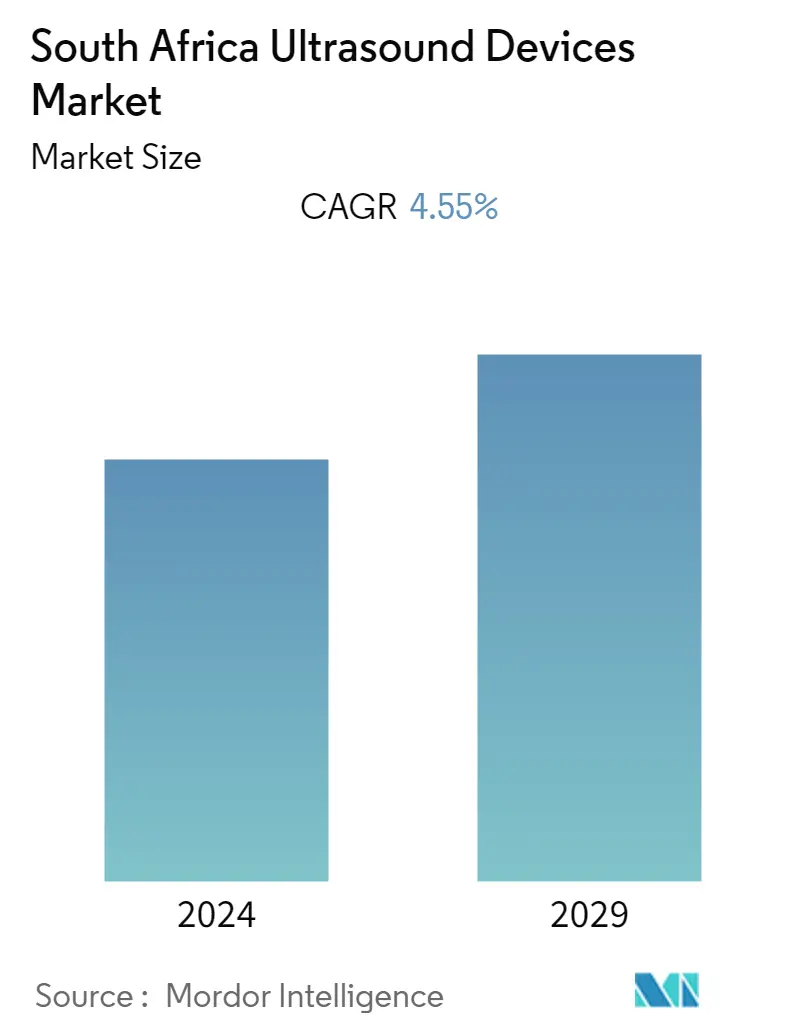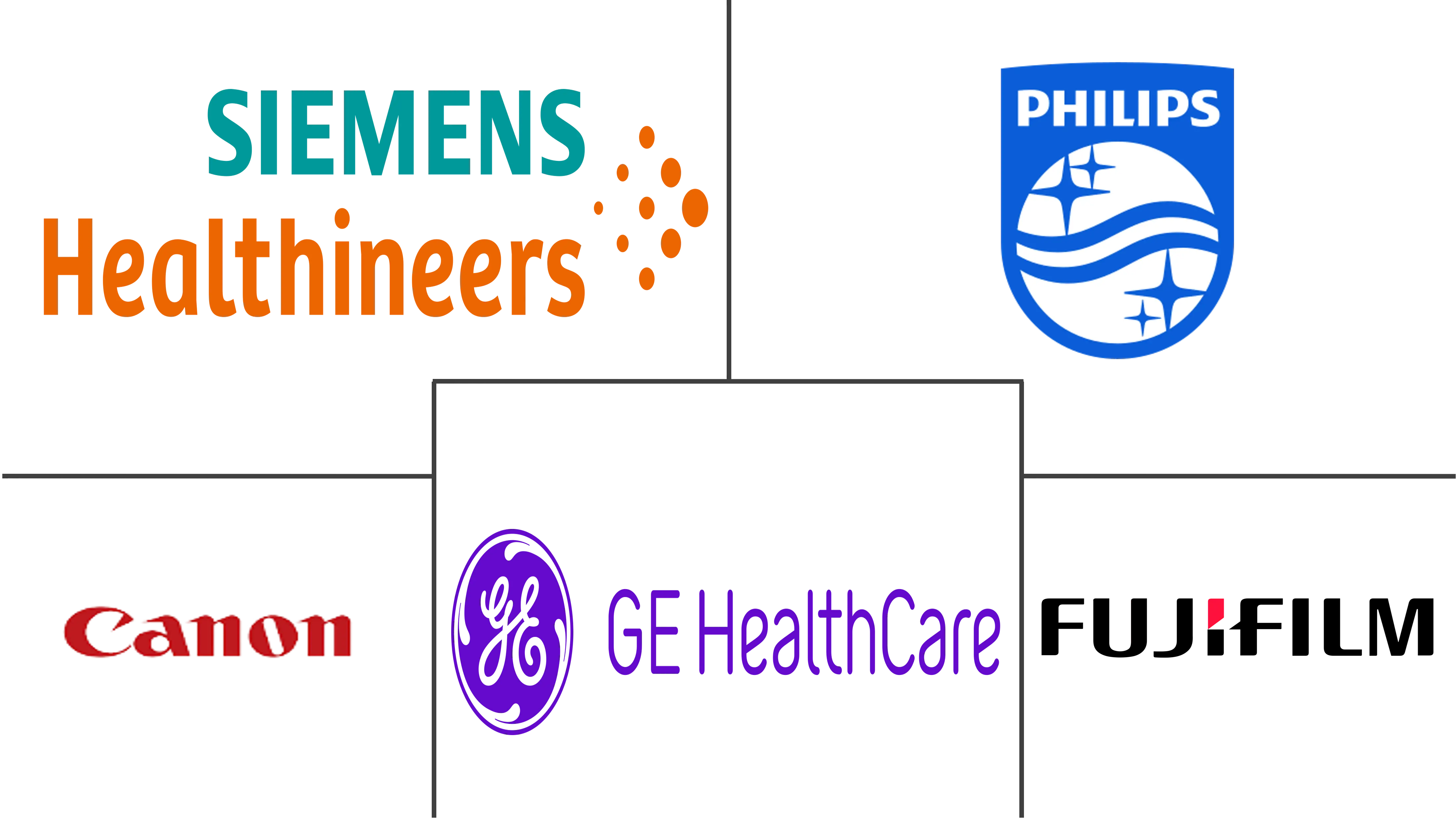Market Size of South Africa Ultrasound Devices Industry

| Study Period | 2019 - 2029 |
| Base Year For Estimation | 2023 |
| Forecast Data Period | 2024 - 2029 |
| Historical Data Period | 2019 - 2022 |
| CAGR | 4.55 % |
| Market Concentration | Medium |
Major Players
*Disclaimer: Major Players sorted in no particular order |
South Africa Ultrasound Devices Market Analysis
The South Africa Ultrasound Devices Market size is estimated at USD 102.84 million in 2023 and is expected to reach USD 128.47 million by 2028, growing at a CAGR of 4.55% during the forecast period.
The COVID-19 pandemic had a slight impact on the South Africa ultrasound devices market initially, with a decrease in the number of ultrasound diagnoses due to the massive influx of COVID-19 patients. However, during the pandemic, the ultrasound imaging of the chest of COVID-19 patients increased, which boosted the demand for ultrasound. For instance, a study published in the Southern African Journal of Infectious Diseases in August 2022 stated that ultrasound chest imaging was carried out in South Africa to document and analyze the chest imaging features in a human immunodeficiency virus (HIV) and tuberculosis (TB) endemic region amid the multiple waves of COVID-19. Also, in the post-pandemic period, the number of COVID-19 patients decreased in South Africa, which led to the resumption of ultrasound imaging for non-COVID and non-urgent medical cases. Thus, the pandemic had a slight negative impact on the South Africa ultrasound devices market initially. However, the resumption of ultrasound diagnosis for other diseases and infections enabled the South Africa ultrasound devices market to grow at a normal pace leading to the increasing demand for ultrasound devices.
The market is expected to grow with the increasing incidences of chronic diseases and improving healthcare infrastructure in the country. South Africa has a growing burden of chronic diseases, including musculoskeletal disorders, cancer, kidney stones, and others, which is expected to increase the demand for ultrasound devices to diagnose these chronic diseases. For instance, the data published by the University of Cape Town (UCT) and the University of the Witwaters in August 2022 stated that cancer incidence is expected to rise to 121 thousand by 2030 in South Africa. The same source also stated that the incidence of breast, prostate, lung, cervical, pediatric, and hematological cancers is expected to increase in South Africa and continue to grow over the next decade. Similarly, according to the data published by the Organization for Economic Cooperation and Development (OECD) in 2021, over 2.6 individuals in every 1,000 people in South Africa had Dementia in 2021. The same source stated that this number is expected to increase to 4.9 individuals in every 1,000 people in South Africa by 2050. Hence, such a vast patient base of chronic diseases in South Africa is expected to increase the demand for ultrasound devices for disease diagnosis, which is expected to drive the market's growth.
Furthermore, the technological advancements in ultrasound devices will likely accelerate the diagnosis of various medical conditions and adoption of these devices, which will contribute to the country's market growth. For instance, a study published in the journal eBiomedicine Lancet by South African researchers in July 2022 mentioned building collaborative standardized image banks to support point-of-care sputum-free ultrasound tuberculosis detection. The study highlighted the use of lung ultrasound imaging with computer-assisted diagnostics (CAD) for the early detection of tuberculosis. Further, a study published in the Nature Partner Journal Digital Medicine by South African researchers in March 2023 underlined the efficacy of machine learning for the accurate estimation of fetal gestational age based on ultrasound images. The study stated that the machine-learning-based model used for the estimation of the gestational age had the mean absolute error of 3.0 and 4.3 days, which outperformed the current ultrasound-based clinical biometry at these gestational ages. Thus, such high efficacy and accuracy of ultrasound imaging, when integrated with the smart technologies of CAD and machine learning, are expected to attract more market players to leverage their ultrasound devices and offer more advanced features to tap the unmet needs of the patients.
Therefore, owing to the aforementioned factors, including the rising burden of chronic diseases and the technological advancements in ultrasound devices, the studied market is anticipated to witness growth over the analysis period. However, a lack of skilled professionals is likely to impede the market growth.
South Africa Ultrasound Devices Industry Segmentation
As per the scope of the report, a diagnostic ultrasound, also known as sonography, is an imaging technique that uses high-frequency sound waves to produce images of the different structures inside the body. These devices are being utilized as both diagnostic imaging and therapeutic modality and have a wide range of applications in the medical field. South Africa, Ultrasound Devices Market is Segmented by Application (Cardiology, Gynecology/Obstetrics, Radiology, and Other Applications), Technology (2D Ultrasound Imaging, 3D and 4D Ultrasound Imaging, and Other Technologies), Type (Stationary Ultrasound and Portable Ultrasound). The report offers the value (in USD million) for the above segments.
| By Application | |
| Cardiology | |
| Gynecology/Obstetrics | |
| Radiology | |
| Other Applications |
| By Technology | |
| 2D Ultrasound Imaging | |
| 3D and 4D Ultrasound Imaging | |
| Other technologies |
| By Type | |
| Stationary Ultrasound | |
| Portable Ultrasound |
South Africa Ultrasound Devices Market Size Summary
The South Africa ultrasound devices market is poised for growth, driven by the increasing incidence of chronic diseases and advancements in healthcare infrastructure. The market experienced a slight initial setback due to the COVID-19 pandemic, which temporarily reduced non-COVID ultrasound diagnoses. However, the demand for ultrasound imaging, particularly for chest imaging in COVID-19 patients, provided a boost. As the pandemic's impact waned, the resumption of ultrasound diagnostics for various medical conditions contributed to the market's recovery and growth. The rising prevalence of chronic diseases such as cancer and musculoskeletal disorders is expected to further drive the demand for ultrasound devices. Technological advancements, including the integration of machine learning and computer-assisted diagnostics, are enhancing the efficacy and accuracy of ultrasound imaging, attracting more market players to introduce advanced features.
The market is also witnessing significant growth in the 3D and 4D ultrasound segments, driven by research highlighting their efficacy in fetal diagnosis and monitoring. The demand for portable ultrasound devices is increasing, supported by studies demonstrating their effectiveness in diverse healthcare settings. Strategic developments by market players, such as distribution agreements and grants to enhance maternal and fetal health, are expected to boost the adoption of portable devices. The competitive landscape includes major global players and local entities, with key companies like Siemens Healthineers, Philips, and GE Healthcare leading the market. Overall, the South Africa ultrasound devices market is anticipated to expand, fueled by technological innovations and the growing need for diagnostic imaging solutions.
South Africa Ultrasound Devices Market Size - Table of Contents
-
1. MARKET DYNAMICS
-
1.1 Market Overview
-
1.2 Market Drivers
-
1.2.1 Increasing Incidences of Chronic Diseases
-
1.2.2 Improving Healthcare Infrastructure
-
-
1.3 Market Restraints
-
1.3.1 Lack of Skilled Professionals
-
-
1.4 Porter's Five Forces Analysis
-
1.4.1 Threat of New Entrants
-
1.4.2 Bargaining Power of Buyers/Consumers
-
1.4.3 Bargaining Power of Suppliers
-
1.4.4 Threat of Substitute Products
-
1.4.5 Intensity of Competitive Rivalry
-
-
-
2. MARKET SEGMENTATION (Market Size by Value - USD million)
-
2.1 By Application
-
2.1.1 Cardiology
-
2.1.2 Gynecology/Obstetrics
-
2.1.3 Radiology
-
2.1.4 Other Applications
-
-
2.2 By Technology
-
2.2.1 2D Ultrasound Imaging
-
2.2.2 3D and 4D Ultrasound Imaging
-
2.2.3 Other technologies
-
-
2.3 By Type
-
2.3.1 Stationary Ultrasound
-
2.3.2 Portable Ultrasound
-
-
South Africa Ultrasound Devices Market Size FAQs
What is the current South Africa Ultrasound Devices Market size?
The South Africa Ultrasound Devices Market is projected to register a CAGR of 4.55% during the forecast period (2024-2029)
Who are the key players in South Africa Ultrasound Devices Market?
Siemens Healthineers AG, Koninklijke Philips NV, GE Healthcare, Canon Medical Systems Corporation and Fujifilm Holdings Corporation are the major companies operating in the South Africa Ultrasound Devices Market.

